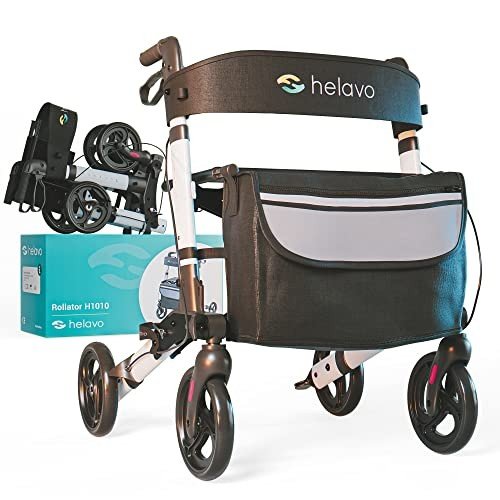
Lightweight Walker
Company Description
13 Things You Should Know About How To Use A Rollator That You Might Not Have Considered
How To Use A Rollator: A Comprehensive Guide
Rollators are mobility aids designed to improve the independence and safety of individuals with mobility obstacles. Unlike standard walkers, rollators are geared up with wheels, a seat, and frequently a storage pouch, allowing users to move with higher ease and convenience. This short article supplies an extensive guide on how to use a rollator successfully and safely, ensuring a smoother and more satisfying walking experience.
What is a Rollator?
A rollator is a wheeled walking aid. It usually has:

- Three or four wheels: Offering stability and maneuverability.
- Hand brakes: For control while walking or when resting.
- A seat: Allowing users to take breaks easily.
- Storage area: Such as a basket or pouch for personal items.
Types of Rollators
There are numerous types of rollators, developed to meet the needs of various users:
| Type | Description | Best for |
|---|---|---|
| Ultra Lightweight 3 Wheel Rollator with Bag-Wheel Rollator | Lighter and more compact, perfect for indoor use | Browsing tight areas |
| Days Breeze 4-Wheel Rollator with Basket – Durable Mobility Rollator | Deals stability and a larger seat, appropriate for outdoor use | Longer strolls and much heavier use |
| Heavy-Duty Rollator | Created to support more weight with additional robust functions | Users requiring additional assistance |
| Pediatric Rollator | Smaller in size, changed for kids | Kids with Mobility Aid limitations |
How to Use a Rollator
Utilizing a rollator properly is vital to guarantee safety and take full advantage of the benefits it provides. Here’s a detailed guide:
Step 1: Adjust the Height
Before using the rollator, it is vital to change the handlebars to the proper height.
- Stand directly: With your arms unwinded at your sides.
- Measure the height: The hand grips need to be at wrist level when the user is standing.
- Safe adjustments: Ensure all locking systems are firmly engaged.
Action 2: Familiarize Yourself with the Rollator
Understanding the elements of the rollator will assist boost its functionality.
- Brakes: Learn how to engage and release the brakes by squeezing the handles.
- Seat: Identify where to sit conveniently when you require to rest.
- Storage area: Know where you can store personal possessions.
Action 3: Start Walking
- Position the rollator: Place it an action ahead of you, guaranteeing that the brakes are released.
- Grip the manages firmly: Keep a light stress in your arms while holding onto the rollator.
- Step inside the frame: Move forward by stepping with one foot and then the other.
- Maintain a straight posture: Walking must be upright, preventing the temptation to lean on the rollator excessively.
Step 4: Utilize Brakes
Always use the brakes efficiently to enhance safety:
- To decrease: Gradually squeeze the brakes.
- To stop: Fully engage the brakes by pulling on both manages.
- To sit down: Ensure the rollator is steady, then thoroughly lower yourself onto the seat.
Step 5: Maneuver with Care
Turning and browsing can be challenging, so here are essential ideas:
- Telegraph your instructions: Look where you want to go before turning.
- Take small steps: Move gently when turning to keep balance.
- Use a three-point turn: Turn from one side to the other, keeping the walker close.
Action 6: Practice Stopping and Resting
Taking breaks is important. Here are ideas for resting:
- Find flat surface areas: Ensure the area is level when you sit.
- Engage the brakes when seated: This will avoid rolling.
- Shift position gradually: When all set to stand again, eliminate the brakes before rising.
Maintenance and Safety Tips
To ensure the rollator remains functional and safe:
- Regularly check the brakes: Ensure they engage and release properly.
- Examine wheel alignment: Wheels needs to not wobble; tighten up any loose screws.
- Clean the rollator: Wipe down surfaces and eliminate particles from tires to maintain smooth operation.
Typical Concerns
Users may face several typical issues when utilizing rollators. Here are some basic FAQs:
FAQs
Q1: Can I use a rollator outdoors?A: Yes, a lot of
rollators are created for both indoor and outdoor use. However, ensure it has the suitable wheel size and tread for outdoor surfaces. Q2: What are the weight limits on rollators?A: Weight limits
normally differ by model, however durable rollators can normally accommodate users weighing around 300 to 500 pounds. Q3: Are rollators adjustable?A: Yes, many rollators include adjustable handle heights to accommodate users of numerous heights
. Q4: How do I transfer a rollator?A: Many rollators canbe folded for practical transport in a vehicle. Always check the user handbook for specific folding directions. Q5: Can I use a Affordable Rollator while recuperating from surgery?A: Yes, many individuals use rollators during healing to gain back strength and balance, but guarantee you follow your doctor’s advice.
Understanding how to use a rollator properly can significantly improve mobility and decrease the risk of falls. Whether you are new to utilizing mobility aids or looking to refine your strategy, following the standards talked about in this post is essential. With practice, a rollator can improve self-reliance while making sure safety, thus permitting users to enjoy a more active way of life.


